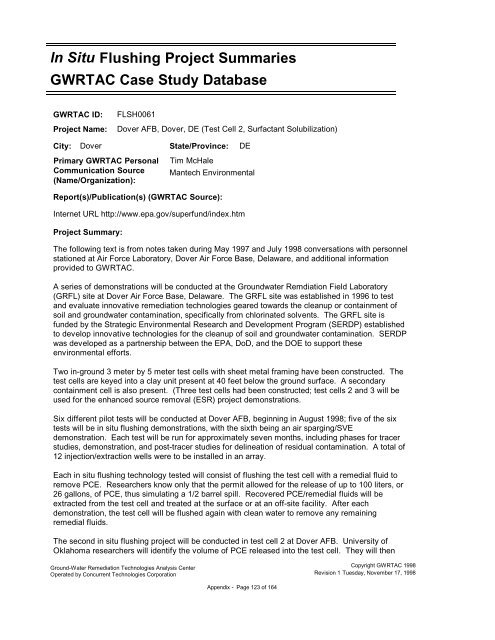Technology Status Report: In Situ Flushing - CLU-IN
Technology Status Report: In Situ Flushing - CLU-IN
Technology Status Report: In Situ Flushing - CLU-IN
Create successful ePaper yourself
Turn your PDF publications into a flip-book with our unique Google optimized e-Paper software.
<strong>In</strong> <strong>Situ</strong> <strong>Flushing</strong> Project Summaries<br />
GWRTAC Case Study Database<br />
GWRTAC ID: FLSH0061<br />
Project Name: Dover AFB, Dover, DE (Test Cell 2, Surfactant Solubilization)<br />
City: Dover State/Province: DE<br />
Primary GWRTAC Personal<br />
Communication Source<br />
(Name/Organization):<br />
Project Summary:<br />
Tim McHale<br />
Mantech Environmental<br />
<strong>Report</strong>(s)/Publication(s) (GWRTAC Source):<br />
<strong>In</strong>ternet URL http://www.epa.gov/superfund/index.htm<br />
The following text is from notes taken during May 1997 and July 1998 conversations with personnel<br />
stationed at Air Force Laboratory, Dover Air Force Base, Delaware, and additional information<br />
provided to GWRTAC.<br />
A series of demonstrations will be conducted at the Groundwater Remdiation Field Laboratory<br />
(GRFL) site at Dover Air Force Base, Delaware. The GRFL site was established in 1996 to test<br />
and evaluate innovative remediation technologies geared towards the cleanup or containment of<br />
soil and groundwater contamination, specifically from chlorinated solvents. The GRFL site is<br />
funded by the Strategic Environmental Research and Development Program (SERDP) established<br />
to develop innovative technologies for the cleanup of soil and groundwater contamination. SERDP<br />
was developed as a partnership between the EPA, DoD, and the DOE to support these<br />
environmental efforts.<br />
Two in-ground 3 meter by 5 meter test cells with sheet metal framing have been constructed. The<br />
test cells are keyed into a clay unit present at 40 feet below the ground surface. A secondary<br />
containment cell is also present. (Three test cells had been constructed; test cells 2 and 3 will be<br />
used for the enhanced source removal (ESR) project demonstrations.<br />
Six different pilot tests will be conducted at Dover AFB, beginning in August 1998; five of the six<br />
tests will be in situ flushing demonstrations, with the sixth being an air sparging/SVE<br />
demonstration. Each test will be run for approximately seven months, including phases for tracer<br />
studies, demonstration, and post-tracer studies for delineation of residual contamination. A total of<br />
12 injection/extraction wells were to be installed in an array.<br />
Each in situ flushing technology tested will consist of flushing the test cell with a remedial fluid to<br />
remove PCE. Researchers know only that the permit allowed for the release of up to 100 liters, or<br />
26 gallons, of PCE, thus simulating a 1/2 barrel spill. Recovered PCE/remedial fluids will be<br />
extracted from the test cell and treated at the surface or at an off-site facility. After each<br />
demonstration, the test cell will be flushed again with clean water to remove any remaining<br />
remedial fluids.<br />
The second in situ flushing project will be conducted in test cell 2 at Dover AFB. University of<br />
Oklahoma researchers will identify the volume of PCE released into the test cell. They will then<br />
Ground-Water Remediation Technologies Analysis Center<br />
Operated by Concurrent Technologies Corporation<br />
Appendix - Page 123 of 164<br />
Copyright GWRTAC 1998<br />
Revision 1<br />
Tuesday, November 17, 1998
















